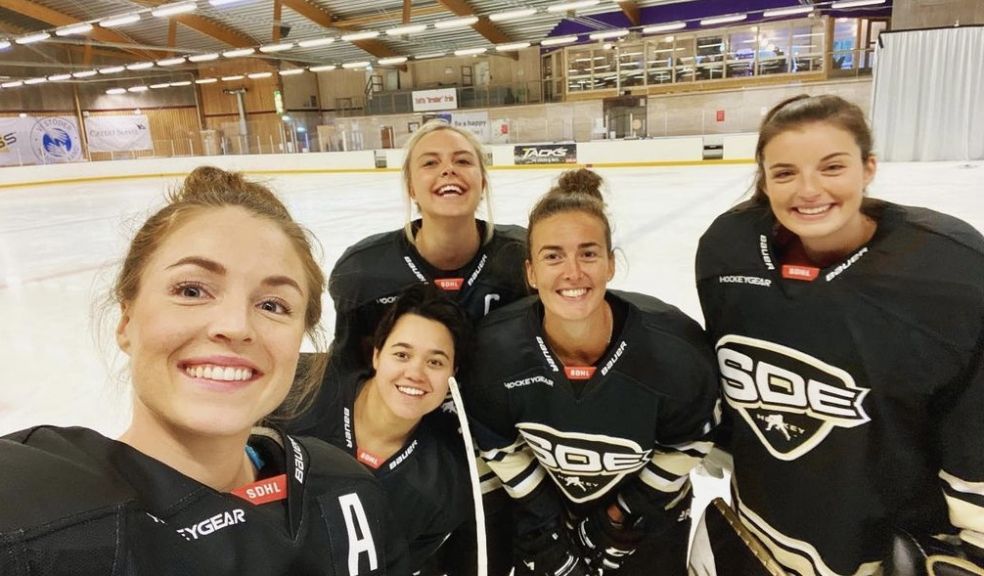
If you can't find a league, you might like Sweden: Q & A with Kelly Murray
Eden Murray interviews her sister, Kelly Murray, about the path she took to playing professional Ice Hockey in Sweden. Although never the original plan to play overseas, Kelly reflects on her experience there, as well as some of her past hockey trials and tribulations that had motivated her to change courses. She speaks on harsh realities that women face in sport, and lends some advice on how female athletes (and everyone else) can work to change current circumstances for many women in sport.
1. Kelly, you’ve been over in Sweden for the past three years, playing professional women’s Ice Hockey. What was your motivation to go over in the first place? And why have you continued to go back?
My initial motivation to go to sweden was because the league I had been playing in prior to Sweden, the CWHL, folded. After the CWHL folded I knew I wanted to keep playing, and my dad had played hockey over in Europe and loved it, so I wanted to give it a try.
I’d heard great things about the Swedish SDHL league from friends who had played here, and I’m grateful I went because it’s given me such a deeper respect for the caliber and quality of European female hockey players. In my opinion it’s the top competitive female hockey league in the world right now.
The reason why I’ve returned for the past three seasons is because I love hockey, and if I had the ability to make a living playing the game that I love, that would be my first choice for a job. As it stands it’s not a financially viable option for my future, so while playing I’m currently studying to get my masters in psychology.
I also see how far my team has come in the past few years, and the sacrifices our Owners and General Manager have made for our team, so another reason why I’ve stayed is out of a sense of love, loyalty and duty to them. To try and help them build a winning team and program, to give back to them just the tiniest amount of what they have given to me and to so many other female hockey players. They don’t make a salary off of this, they do it out of pure love for the game and because they want to help move women’s hockey forward.
2. What are the biggest differences between playing hockey in Sweden vs. North America?
Well the rinks are different sizes for starters. In the SDHL we play on larger Olympic-sized ice sheets so that changes how the game is played a little bit. And also how popular the game is over here. Hockey is definitely a very popular sport in Sweden, but it’s not to the same level as the Canadian people’s obsession with the game. Which makes it even more sad that North America doesn’t have a salary-paying professional league for women’s hockey. How can you claim to be the home of the best female hockey in the world, claim as governments to be the trendsetters and forward thinkers in the world, when you don’t even have a professional league that allows players to live off the salaries they make playing their sport?
To be honest though, the quality of hockey and the skill levels of top players are quite similar. It’s very fast, skilled, competitive hockey. Some programs in Europe have put a lot of time and money into their women’s hockey programs and it shows. The Finnish national team and the Japanese national team being two great examples.
3. Prior to Sweden, you played professionally for the top women’s league and professional team in the world (Calgary Inferno, CWHL) for two years. What was the day to day like in this league?
Day to day was dependent on whether you were working or not. We would practice early in the morning, at around 7 am, and then the girls who had to get to work would leave right after practice. If you had time, we would then work out in the gym at Winsport. Some girls who were apart of their national team programs were able to have more flexibility in their daily lives, if their compensation from the national team allowed them to work part time. It was a very demanding league, time-wise, but it was worth it. Seeing young girls (and boys!) in the stands at games wearing our jerseys and having them come down afterwards for autographs. All the girls playing in our league knew that even if you were dead tired after a game, you had a duty to these young fans to go say hi and do your best to try and help inspire the next generation.
4. In your opinion, why did the CWHL fold? What do you think needs to happen in order to have a sustainable top Women’s Professional League in the world?
I believe that when they had two leagues running at the same time, it really hurt the strength of the CWHL. Potential funding was being split, and it wasn’t financially sustainable. And I can’t say for sure what I think would be the most sustainable plan moving forward. Of course it would be wonderful if women did not have to rely on men to fund our futures, but unfortunately in elite sports a lot of the money is currently sitting in the men’s pockets. I think the most logical option is to have the NHL step up and openly invest in a women’s hockey league. This does not mean the NHL would need to be the sole owners, but if they were able to apply the structure, facilities and even 40-50 percent of the financial backing needed, that would give other investors the confidence to put their money in a league that has so much potential for the future. The SDHL is a fantastic league, but the majority of women in our league do not make salaries from their teams. And if players do have salaries, it’s just enough to cover rent and food. Not enough to actually live a comfortable life or save for the future.
5. What advice do you have for young aspiring female athletes? How can they help move the needle closer towards having viable leagues for their sport?
I think one of the best things young female athletes can do is to demand equality at all levels. If you are in high school and playing for a AAA level club which also has a AAA men’s team, and you find out there’s some big gap in equality between the two- fight it. Make it known that you won’t allow an inequality to exist between two teams at the same level. It makes me sad that I even have to suggest to girls that they need to start fighting inequality at such a young age. But unfortunately that’s the world we are currently living in. Where the most elite female athletes in the world have to fight for a liveable wage, and have people resisting it or disagreeing. The positive note to all of this is the hard work IS paying off. There are countless women and men who are fighting for the same thing [WNBA, NWSL, NWTA, to name a few], and their voices are starting to be heard! I am hopeful that in the next five years we will see a league that is both financially stable and able to pay liveable wages to all their athletes.









